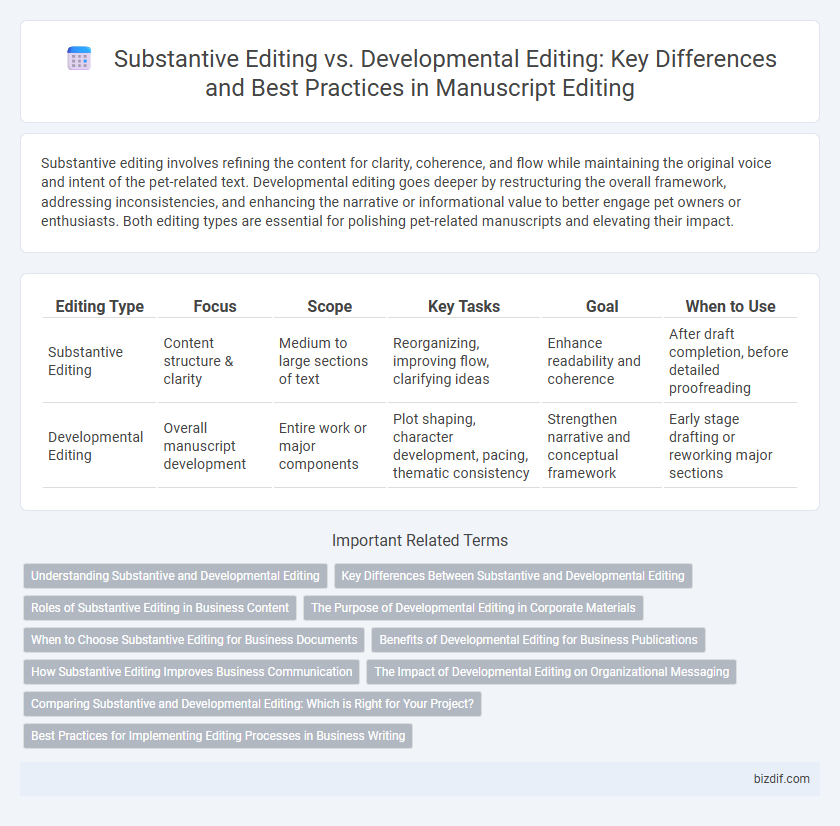Substantive editing involves refining the content for clarity, coherence, and flow while maintaining the original voice and intent of the pet-related text. Developmental editing goes deeper by restructuring the overall framework, addressing inconsistencies, and enhancing the narrative or informational value to better engage pet owners or enthusiasts. Both editing types are essential for polishing pet-related manuscripts and elevating their impact.
Table of Comparison
| Editing Type | Focus | Scope | Key Tasks | Goal | When to Use |
|---|---|---|---|---|---|
| Substantive Editing | Content structure & clarity | Medium to large sections of text | Reorganizing, improving flow, clarifying ideas | Enhance readability and coherence | After draft completion, before detailed proofreading |
| Developmental Editing | Overall manuscript development | Entire work or major components | Plot shaping, character development, pacing, thematic consistency | Strengthen narrative and conceptual framework | Early stage drafting or reworking major sections |
Understanding Substantive and Developmental Editing
Substantive editing involves a comprehensive review of a manuscript's content, structure, and flow, focusing on clarity, coherence, and overall readability. Developmental editing delves deeper into the conceptual framework, addressing issues such as plot development, character arcs, and thematic consistency to strengthen the foundation of a work. Both editing types play critical roles in refining a manuscript, with substantive editing enhancing form and style, while developmental editing shapes the core narrative and purpose.
Key Differences Between Substantive and Developmental Editing
Substantive editing focuses on improving the structure, clarity, and flow of a manuscript by addressing paragraph organization, sentence coherence, and factual accuracy. Developmental editing involves a deeper analysis of content, including plot development, character arcs, pacing, and overall narrative structure to enhance the story's effectiveness. Key differences include the scope: substantive editing refines existing text for greater readability, while developmental editing shapes the work's foundation to ensure conceptual strength and engagement.
Roles of Substantive Editing in Business Content
Substantive editing enhances business content by refining structure, clarity, and coherence to ensure the message aligns with strategic objectives and target audience needs. It involves reorganizing information, improving flow, and clarifying complex ideas to elevate the overall impact and engagement of reports, proposals, and marketing materials. Effective substantive editing bridges the gap between raw data and persuasive communication, driving better decision-making and stakeholder alignment.
The Purpose of Developmental Editing in Corporate Materials
Developmental editing in corporate materials aims to enhance the overall structure, clarity, and effectiveness of the message to align with the company's objectives and target audience. This process involves evaluating content organization, consistency, and tone to ensure the material effectively supports branding and communication goals. The purpose is to create compelling, coherent documents that drive strategic outcomes and facilitate stakeholder engagement.
When to Choose Substantive Editing for Business Documents
Substantive editing is ideal for business documents requiring clarity, consistency, and precision without altering the core structure or message. Choose this editing type when the document's content is mostly complete but needs refinement in language, tone, and style to enhance professionalism and readability. It ensures polished communication while maintaining the document's original intent and factual accuracy.
Benefits of Developmental Editing for Business Publications
Developmental editing enhances business publications by improving overall content structure, clarity, and coherence, ensuring the message aligns with company goals and audience needs. This process identifies gaps, refines the narrative flow, and optimizes the effectiveness of the communication strategy to boost reader engagement and comprehension. By addressing core content issues early, developmental editing significantly increases the publication's professional impact and market relevance.
How Substantive Editing Improves Business Communication
Substantive editing enhances business communication by refining content structure, clarity, and tone to align with target audience expectations, ensuring messages are compelling and effective. This process involves reorganizing information, eliminating redundancies, and improving coherence, which helps organizations convey complex ideas succinctly. By addressing these elements, substantive editing boosts professionalism and engagement in corporate documents and presentations.
The Impact of Developmental Editing on Organizational Messaging
Developmental editing transforms organizational messaging by aligning content with strategic goals, enhancing clarity, and ensuring consistent brand voice across all communications. It addresses structural and thematic elements, enabling organizations to effectively convey their mission and values to target audiences. This process significantly improves audience engagement and strengthens the overall impact of corporate communication.
Comparing Substantive and Developmental Editing: Which is Right for Your Project?
Substantive editing sharpens content clarity, coherence, and flow by focusing on restructuring and refining existing text, while developmental editing involves shaping the manuscript's overall structure, theme, and organization from the ground up. Choosing between substantive and developmental editing depends on your project's stage: substantive editing suits nearly finished drafts needing polish, whereas developmental editing is essential for early-stage manuscripts requiring significant conceptual and structural development. Understanding the scope and intensity of each editing type ensures effective collaboration with editors, optimizing your manuscript's impact and readability.
Best Practices for Implementing Editing Processes in Business Writing
Substantive editing restructures and refines content for clarity, coherence, and flow, while developmental editing involves deep analysis of the overall structure, argument, and purpose. Best practices for implementing editing processes in business writing include establishing clear style guides, using collaborative tools for real-time feedback, and scheduling multiple review stages to ensure thorough content refinement. Prioritizing targeted edits based on the document's purpose improves communication effectiveness and aligns the final product with strategic business goals.
Substantive Editing vs Developmental Editing Infographic

 bizdif.com
bizdif.com